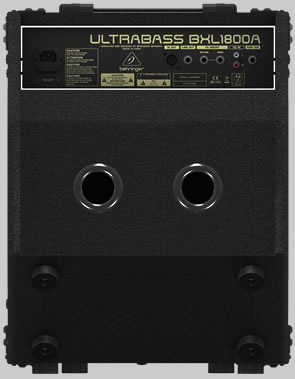Better than a practice amp

Behringer Ultrabass BXL1800A Both solid and compact, the BXL 1800A is an overrated budget bass amplifier with a good range of useful (if somewhat eccentric) features.
Inputs: |
GEAR RELATED ARTICLES
[Home Music Recording Studio]
GUITAR AMPLIFIERS:
Acoustic 450 - 170W Guitar / Bass Amp Head
Behringer Ultrabass BXL1800A 180W Bass Amp
Fender Princeton Chorus 51W Compact Amp
GUITARS:
Aspen AD25 6 String Acoustic Guitar
Esteve Model 8 Classical Guitar
La Patrie Concert CW QIT Classical Guitar
La Patrie Presentation Classical Guitar
Fender DG-14SCE Nat Acoustic Guitar
Godin XtSA Electric Guitar
Godin Freeway Classic Electric Guitar
Ibanez RG8 8 String Electric Guitar
Jim Beam Devil's Cut 335 clone
Maton EM125C - 6 String Acoustic Guitar
Maton EM425C/12 12 String Acoustic Guitar
Maton Mastersound MS500 - 6 Str Electric Guitar
Yamaha FG-410-12A 12 String Acoustic
Yamaha G-228 6 String Classical
GUITAR FX - The Chronicles of Zoom:
ZOOM GFX-707 - Review and Description
ZOOM 707 II - Review and Description
ZOOM BFX-708 - Bass Guitar Multi Effects Pedal
ZOOM G9.2tt - Guitar Effects Console
Behringer EM600 Echo Machine Stomp Box
Behringer RV600 Reverb Machine Stomp Box
ROLAND U-220 - Vintage Sound / Synth Module
SN-U110 and SN-MV30-S1 Series PCM Cards
Behringer FBQ1502HD Ultragraph Pro
Behringer Eurorack Pro RX1602 Rackmount Mixer
Capabilities of the CASIO WK-7500 Workstation
Presonus Eris E5 Powered Monitor Speakers
Vonyx (Skytec) SPJ-1000A Active 10" Speaker
[ Advertising ]
The Behringer Ultrabass BXL1800A is a budget, compact Bass Amplifier package which certainly has a respectable kick for its size. It is however no light-weight at almost 22Kg (45 lbs). That said, this amp is more than adequate for rehearsals and will hold its own in smaller venues.
The provided DI (balanced Direct Inject output) makes shunting the Ultrabass to a mixing desk, PA and/or recording gear very simple. Thus also handy if you should need that extra bit of grunt via the PA or another (slave) amp.
The Ultrabass part of the name is for the built-in octave divider which can be used to provide some additional bottom end. The Ultrabass effect can be switched in/out from either the front panel or by the provided foot-switch. I'm not sure whether they all shipped with a dual footswitch, as the one I have was given to me as a collection of disassembled parts. The footswitch is however readily available online and also would not be a challenging project to build.
All up, the Ultrabass BXL1800A is not a bad little amp, but as mentioned, in its day it was at the 'budget model' end of the scale. This currently being the domain of the very similar looking 100W Joyo JBA100 and 80W Beta Aivin BP80, and it really is a classic case of 'you get what you pay for'.
While the Ultrabass BXL1800A does a respectable job as a bass amp, it's never going to live up to the ridiculous and all pervasive (BS) marketing hype which seems to have been 'cut-n-paste' copied for almost every review of this amplifier.
The suggestion from the marketing hype is that the Ultrabass BXL1800A is an awesome piece of kit and includes statements like:
"When a stack is too high and a practice amp just doesn't cut it ... [insert a pile more BS here] ... With 180 Watts of output horse power, your performance will never run out of breath."
Hmm, measuring an amplifier's performance in horsepower now ... that's novel ... I guess.
For those interested 200W = 0.268097 hp (electrical).
Doesn't really sound that impressive when you actually do the maths, does it? ;-))
The last of these amps that I saw for sale new, were around AUD $450 (or less) and that included shipping.
It really would be amazing, if this amp could deliver anything even close to a real 180 Watts of output for that price.
So what do I mean by 'a real 180 Watts' ? Very simply, I mean the RMS rating, which is also referred to as the continuous power output capability of an amp.
Now, in fairness to Behringer ... a couple of important points to note:
- Firstly, Behringer have been very careful not to mention the RMS suffix anywhere in their Bass Amplifier literature. Therefore, they can't be directly accused of false advertising.
Given that Behringer don't mention that it's peak power either, I would consider that to qualify as at least 'a little misleading'. The meaning and interpretation of Behringer's specifications are, it seems, left to the imagination of the prospective customer.
- Secondly, there seems to be almost a tradition amongst some (dare I say many) amp manufacturers to use the peak output power of an amp, in the amp's model number.
Take that old classic the Acoustic 450 Lead/Bass amp from back in the '70s. While it could deliver an honest 170W RMS, it could readily handle 450W peak. Of course in the case of Behringer, they've also added an extra "0" (zero) at the end of the model number (making it 1800 instead of 180). I guess that indicates that they believe that it goes even harder ;-)
There are however some obvious clues as to what the BXL1800A can, or perhaps more correctly 'can't' deliver.
One rather obvious clue is is that the 12" Bugera speaker provided with the Behringer BXL1800A has a stated power handling capability of 120 Watts. This rating is mentioned in the specifications, just a few lines below the amp's 180W power rating and is also stated/printed on the actual speaker. Again, there is no mention of either Peak or RMS power in either case.
Electronic engineering, common sense and most musicians would suggest to you that, if you were to put a continuous 180W of power into a speaker rated at 120W, you wouldn't be doing so for very long. In fact, the speaker voice coil is very likely to end up toasted. That suggests that the amp's claimed 180 Watts of output would very likely be peak or momentary power handling capacity only (variously referred to as PP, Peak Program or Peak Power).
Generally speaking, manufacturers will roughly double the RMS figure to provide a peak output level. Following that logic the Behringer Ultrabass BXL1800A is in reality likely to be something along the lines of a 90W to perhaps100W bass amp. More on that later ...
Unlike most reviews or descriptions of the Behringer Ultrabass BXL1800A amplifier, I have the advantage of having repaired and restored a BXL1800A with a toasted Power Amp / Power Supply board (shown below at close to actual size ).
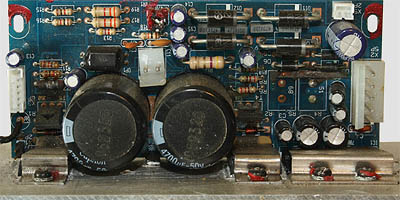
In other words ... I've seen its guts, as well as the physical result of someone thinking that they were going to get 180 Watts out of this sucker.
Long story short ... it's not a good look.
So this review is based on a Behringer BXL 1800A that has been, quite literally, brought back from the dead. Which in fairness, may actually be far more meaningful if you are considering purchasing one of these amps.
Some of the immediate up-sides to all of this are, that I can tell you - that:
- Official Behringer replacements parts (power amp module) are now almost impossible to come by (updated Sept 2021).
- A replacement Power Amp / Power Supply Module for the Behringer BXL1800A was relatively affordable. Which in the past made a Power Amp repair (transplant) a realistic option (assumed all the other components were still functional, particularly the transformer).
- Replacing the Behringer BXL1800A Power Amp / Power Supply module was relatively straight forward ... for an electronics technician / repairer.
IMPORTANT: I would not recommend this as a novice DIY project, since there are lethal voltages involved and the final setup (specifically, biasing the output stage) requires the amp to be powered up.
Also the more recent replacement amp modules were slightly different and required the technician to swap over some components from the old module (not at all as easy as it sounds, since there are tiny surface mount components that must be handled and/or avoided during this process).
- Assuming there were no other issues and parts could be acquired, a full Power Amp replacement could probably be done for between AUD $200 to $250, by most competent technicians / repairers ... which would still be around half the price of a new BXL1800A or similar 'budget' bass amp.
If any other components were also damaged (particularly the power transformer), then I would classify what was left as either ready for the recycle bin, or at best, spare parts. There is nothing so awesome about this amp that you'd want to keep any of it for sentimental reasons.
- This power amplifier / power supply module could easily be rebuilt from scratch (if one was sufficiently motivated to do so) and almost certainly could be improved in the process (with upgraded components, thicker copper tracks and a more resilient circuit board layout).
On to some specifics. I will cover the Power Amp module first, then go into the amp's "features".
Behringer 180W Power Amplifier and Power Supply Module (7/10)
The almost minute Power Amp module for the Behringer BXL 1800A also houses the Power Supply for both the power amp (±45V rails) and for the Pre Amp / EQ circuitry (±15V rails) and an also an unused 24V rail for use with a fan. The photo provided is of a brand new module sitting on a standard CD case to give a size reference ... and yes, it really is that small. 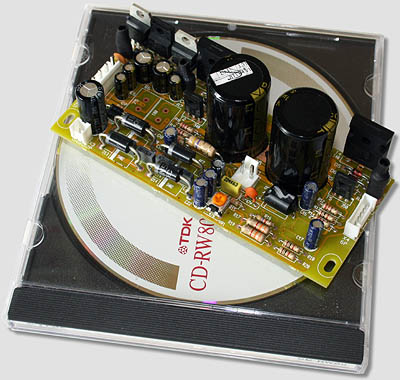
The business end (output stages) of the power amplifier board are two well spec'd and quite robust IRFP9140N HEXFET® Power MOSFETs.
Essentially the power amplifier design is that of a simple symmetrical output stage where the actual power output is limited by the Supply Voltage (in this case ±45V) and the available current from the transformer.
The power transformer is actually the single most expensive part of the whole amp to replace, if it is damaged.
The problem with the BXL1800A Power Amplifier board is not the final output stage, but the less robust components and PCB (Printed Circuit Board) tracks that come before this. I would simply call it over-engineered. That is, trying to cram too much into too little circuit board realestate.

As evidenced by the previous photo of the failed power amplifier board (which had already been modified and/or repaired at least once before), over heating was the primary cause of failure. Most likely via gradual and incremental degradation of the printed circuit board over an extended period.
Even the built in thermal protection is quite obviously not sufficient to prevent the inevitable self-destruction of the power amplifier board. A search online will reveal that these 'over-heating related' failures are not uncommon.
I was told by the former owner that the amp had been reliable and lasted for around 3 to 4 years before failing. Given the low initial purchase price and the 3 year manufacturer's warranty, this would have to be considered acceptable. I still consider this yet another fine example of designing for failure. If nothing else, I guess it keeps your loyal customers thinking about upgrades every few years.
It does not bode well though for those thinking of purchasing a used BXL1800A bass amp. Without examining the power amp circuit board, there is no way to know how imminent a failure might be. Unless of course the current owner has evidence that the Power Amp has already recently been replaced.
In summary the BXL1800A Power Amplifier board is a fine example of modern circuit design efficiency. Everything is neat, tidy and built to the minimum specification (minimum cost) required to do its job. A slightly larger, better cooled and more robust design would have lasted longer ... but why do that? right? That won't sell more/new amplifiers.
Behringer Bugera 120W Hard Attack Bass Speaker (8/10)
The Bugera 120W Hard Attack bass speaker is a surprisingly robust unit that can survive quite a bit of punishment and still perform well for a 12" bass speaker. I had to panel beat the speaker chassis back into shape after it fell from a height of around 2m (just over 6'). There was only slight audible degradation. Even the cat that caused the event survived ( -1 life ;-)
Given that the Behringer Ultrabass BXL1800A is a budget model bass guitar amplifier, it should come as no surprise that the included Bugera 120W Hard Attack bass speaker is similarly a budget speaker. Albeit, a well made one for a pressed metal chassis. The 'A' suffix at the end of the model number (BXL1800A) denotes Aluminium cone.
While the Aluminium cone and 50mm (2") Aluminium voice coil will no doubt assist in heat dissipation, the rest of the construction is fairly ordinary. The speaker chassis is lightweight and pressed metal (not the superior cast alloy), and the magnet is unimpressive. This immediately suggests that the efficiency of the speaker will be average at best. Behringer again cleverly avoid providing information like the speaker's efficiency or SPL. SPL stands for Sound Pressure Level, which is usually described as the number of dB (deciBels) measured at 1 meter with a 1 watt input.
The image below provides a simple comparison of two aluminium cone speakers, the 12" Bugera Hard Attack bass speaker (at right) and a 12" JBL bass speaker (at left).
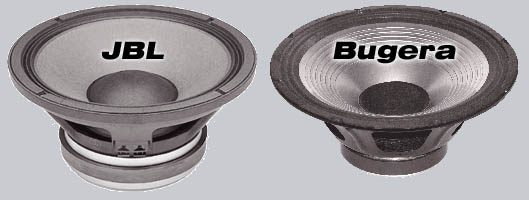
Note the substantially larger magnet on the JBL bass speaker.
While magnet size is one of the more obvious signs of the magnetic flux a speaker is likely to produce, the voice coil area within that region of flux and the size of the gap that the voice coils sits in, also greatly effect a speaker's efficiency. The JBL speaker pictured has a larger 75mm (3") aluminium voice coil, partly because it is rated at 300W RMS and quite simply requires a heavier gauge of copper wire.
The JBL speaker shown would also cost several times as much as the Bugera, so the JBL is shown purely as an example of what a more efficient speaker might look like. Frequency response and tonal accuracy are also required of a good speaker and sometimes efficiency is sacrificed to achieve them (particularly in Audiophile speakers).
Put simply ... a speaker rated at an SPL 98dB (@ 1 watt, @ 1 metre) will be 6dB louder than one rated at SPL 92dB. To our ears, that equals twice as loud!
Whenever a manufacturer has a speaker with an efficiency above SPL 95dB, they usually like to mention it ... it's essentially bragging rights.

Advantages of an Aluminium Voice Coil
Aluminium speaker Voice Coils have been used for decades. They excel in high power musical instrument speakers thanks to their light weight, rigidity and good heat dissipation. A speaker with an Aluminium voice coil can run closer to its power handling limit for longer periods with reduced likelihood of physical distortion (flexing/warping) and/or failure of the voice coil.
Advantages of an Aluminium Speaker Cone
Aluminium and aluminium alloy speaker cones provide both low mass and rigidity, which are desirable features in speaker design. An aluminium speaker cone (when properly attached to an aluminium voice coil) essentially acts as an extended heat-sink for the voice coil. This again slightly raises the power handling capacity of the speaker with respect to heat dissipation, without requiring a heavier voice coil construction.
Disadvantages of an Aluminium Speaker Cone
Using a metallic speaker cone, by its very nature, will result in a brighter overall tone. This is great for reproducing higher frequencies and harmonics, but perhaps somewhat of a drawback for a dedicated bass speaker, where the emphasis should be on the 'bottom end'. I suspect that Behringer tried to head off comments exactly like these by naming/describing the speaker as 'Hard Attack'. No doubt a direct reference to the 'brightness' of this supposedly bass speaker. Note that other manufacturers also make Aluminium cone bass speakers.
While speaker cone rigidity is good for improved frequency response and reduced distortion, it can be problematic if the cone is damaged. Unlike paper / polymer cones that might pop back into shape after receiving a knock, an aluminium cone may end up deformed/creased and literally require some gentle panel beating to restore to its proper shape. If the cone shape distortion is not remedied the voice coil may develop a 'ringing' at certain frequencies caused by the voice coil rubbing against the magnet. At which point a cone repair/replacement may be required.
Missing Information
Sadly there appear to be no meaningful specifications provided for the Bugera 120W Hard Attack bass speaker (like: SPL, Frequency Response, actual RMS power handling). In cases like this I tend to assume that this is information that the manufacturer does not want you to know. Generally, you don't need to be a genius to work out why that might be.
Sound of the Bugera 120W Hard Attack bass speaker
The resulting sound of the Bugera 120W Hard Attack bass speaker in the provided BXL1800A dual ported cabinet is surprisingly good for a single 12" bass speaker. I tend to use it without any EQ because I don't mind some brightness and harmonics with my bass sound. Not surprisingly, the Bugera 120W Hard Attack speaker provides very good presence and also a solid kick for such a small package.
Though it can certainly move some air (you can feel it shake your innards), I suspect the speaker cabinet dimensions and porting provide the tuning that keeps the speaker's frequency response down low where it needs to be. The BXL1800A works fine with guitar also, just FYI (some EQ'ing required).
Behringer Ultrabass BXL1800A Pre Amp & Controls (7/10)
One thing you certainly could say about this amp is that it is different. How sound the logic is behind that difference ... well ... you decide.
On the front panel ...

The Behringer Ultrabass BXL1800A is a single input amp, with two selectable and independently gain controlled channels.
Channel A has only a Gain Control and is intended as the 'clean' channel.
A Channel A/B selector switch sits between the Channel A and B controls (the Footswitch can also be used to switch channels).
Channel B provides some extra tonal variation and dirt by providing a Gain Control, Shape Control (preset tone control options), then finally a Level Control. This allows for some interesting tonal variations and distortion if the gain is ramped up. It's interesting to note that the Shape Control is actually a multi-position switch with no indents, meaning that there are a series of specific predetermined settings available. There is however no documentation or description for or about any of these settings. Apparently, the preamp schematic is a closely guarded secret (you've got to be kidding me ;-)
FBQ Equalizer - The traditional Tone Controls have been replace by a 7 Band Graphic EQ with a respectable 12dB of boost/cut. When not in use, the FBQ Equalizer lights up with all LEDs on. When switched on the LEDs act as a Spectrum Analyzer allowing level adjustments to be made accordingly. In short, the Spectrum Analyzer is a bit of a gimmick, it doesn't really provide much in the way of useful visual information.
Compressor - There is a useful built in Compressor available, which has a single depth control and In/Out switch. It is a seventies tech optical LED and LDR (Light Dependant Resistor) combination. While simple and electronically very basic, it is reasonably effective for providing some extra punch and reducing overall dynamic range. Use sparingly, as the sound can get very muddy with high compression settings.
Ultrabass - And of course there is the 'Ultrabass' function (in Behringer speak the Switchable Ultrabass subharmonics processor), which is actually an octave divider circuit with a blend knob to control the effect's overall depth. This has a front panel In/Out switch and/or may be controlled by the accessory footswitch. In fairness, if you are not into the sound of Octave Dividers, this effect won't impress you. It can however add some sub harmonics (extra growl) to the overall bass sound when used cleverly/sparingly. So, it's not at all wasted electronics. It is however, another throw-back to the late seventies.
And finally, a Master Level knob sits appropriately at the end of the controls, allowing the overall level to be capped, followed by the Headphones Socket and Power Switch.
On the rear Panel ...

Direct Inject & Line Out - Providing a Balanced Output (500Ω) is a nice touch and makes hooking this amp up directly to a mixer or recording desk nice and simple, as it should be. This is followed by an equally useful and standard 6mm (1/4") mono Line Out (100Ω) socket.
FX Insert - An FX Send and Receive line are included to allow connection to external bass effects pedals (sadly, actual level information is not provided). These in/out points are electronically located immediately after the EQ section.
CD In provides two RCA inputs (for L/R) each of which is simply summed via a 20kΩ resistor (i.e. mixed down to mono) and added directly to the output just prior to the Master Volume control.
The Footswitch (if available) is provided with a very generous cable length and controls the Channel A/B Select and Ultrabass On/Off.
Altogether, a very useful if basic set of options. It's a bass amp, it does that job well and does not require a pilot's licence to operate.

The original Sales Pitch ...
Powerful 180-Watt 2-channel bass amplifier with wedge-shaped cabinet
Original BUGERA 12" Hard Attack aluminum-cone speaker
Clean channel with dedicated Gain control
Distortion channel with dedicated Gain, Shape and Level controls.
Ultra-musical, active 7-band graphic EQ with FBQ Spectrum Analyzer Revolutionary "see what you play"
FBQ frequency indicator for instant sound shaping
Switchable Ultrabass subharmonics processor for unbelievable low-end power
Integrated Compressor smoothes out volume peaks when playing dynamic slaps
Musical opto-limiter for ultimate volume without distortion
Dual footswitch for channel select and Ultrabass function included
Separate Headphone output—perfect for quiet practicing
Balanced XLR DI and Line outputs for direct connection to your mixing console
CD input allows you to play along to your favorite music
Dedicated FX Insert for external effects devices (stomp boxes, rack effects, etc.)
3-Year Warranty Program* Designed and engineered in Germany
--- and, there's more ...
ULTRABASS BXL1800A
Not every gig calls for a huge bass rig, so we designed the incredible 180-Watt BXL1800A specifically for those occasions – and we loaded it with amazing features and awesome functionality! With 180-Watts pumping through an original BUGERA 12" Hard Attack aluminum-cone speaker, you'll have more than enough sound to serve up tight and punchy bottom-end for a wide range of performance applications. But power is not all the BXL1800A has to offer – you get 2-channel operation for everything from super-clean tones to sweet distortion-laced grind; a 7-band graphic EQ, with our revolutionary “See-What-You-Play” FBQ frequency indicator that allows you to instantly call up your favorite sounds; a switchable ULTRABASS subharmonics processor for massive depth; a built-in Compressor, for your slap licks – and a host of other professional features and I/O options.
Secret Weapon #1 Tone. That's what it all comes down to – and the BXL1800A really delivers! Channel 1 provides squeaky-clean operation for the most true-to-life sound of your bass. If you prefer a more aggressive sound, switch to Channel 2 via the front panel button or the supplied dual-function footswitch, and use Gain 2 to dial in the perfect amount of grind. For even more tonal variation, we've provided our proprietary Shape control, which lets you call up a broad range of sounds – anything from mild to wild! And if your gig calls for two basses, say a fretted and a fretless, you can use Channel 2 and the Shape control to fine-tune the sound of that second instrument.
Onboard 7-Band FBQ Equalizer Our revolutionary FBQ Equalizer allows you to “see-what-you-play”. In normal mode the individual frequency bands can be raised or lowered to fine-tune your sound; but when you engage the FBQ button, you get the power of a dedicated spectrum analyzer right at your fingertips. Now the LEDs on the frequency sliders illuminate in varying levels of intensity, showing you exactly which bands need to be adjusted for optimal performance. This is especially handy for eliminating the low-frequency feedback typically associated with hollow-body, electric-acoustic and upright basses.
Studio-Quality Compressor - Stairway to Heaven. Our studio-grade compressor is based on classic and famous studio equipment from the 70's. This totally transparent and musical compressor design allows your full dynamic range to shine through until your signal reaches the compression threshold, which is indicated by the highly visible status LED. The compressor increases sustain and gently smoothens out signal peaks, which is especially handy when you're laying down the funk, à la slap and pop – or hammering home your most-aggressive metal lines. The resulting output level lets you unleash powerful and impact-laden bass lines, while still sitting right where you need to be in the mix!
Well, the Compressor design (which works ok) uses a simple, shitty little opto-coupler circuit which is definitely from the seventies and which is just as definitely NOT 'studio-grade' (then or now).
~ Damn!, I wish I could bullshit like that! ;-))
Build Quality of the Behringer Ultrabass BXL1800A (7/10)
The discontinued Behringer Ultrabass BXL1800A was made in China to Behringer's German design and specifications. This is a fairly common approach to producing affordable audio gear. As such, the build quality was quite reasonable for the price space the amp occupied when first released. For the most part, it was a solidly built piece of kit that can suffer some abuse and still earn its keep. Good but not exceptional.
Durability & Reliability of the Ultrabass BXL1800A (6/10)
The BXL1800A that was repaired outlived its warranty period of three years, but not by much.
Whilst, as mentioned earlier, the power amp design is somewhat wanting, the rest of the amp is actually quite solidly built. The failings of this amp come squarely down to the power amp PCB design (the German part) not the manufacturing (the Chinese part). So the flaws were designed in, as it were (inadvertently or otherwise). Since the same power amp module is used across multiple Behringer bass amp models, well there is really no excuse, is there?
Review Ratings (Revised 2023):
- Ease of Use - 7 / 10 (largely set and forget, the FBQ Equalizer is a bit strange)
- Sound - 8 / 10
- Build Quality - 7 / 10
- Durability, Reliability and Repairabilty - 3 / 10 (probably not the best choice to purchase used)
- Value for Money - 5 /10 (if looked after and not thrashed)
- Overall Average Score, an unremarkable ... 6 / 10
Your comments and contributions since 2015 have been greatly appreciated.
Due to the age of this amplifier and more importantly, the unavailability of some parts, this amp would need a knowledgeable electronics enthusiast or technician to complete any meaningful rebuild or repairs. I couldn't recommend the BXL 1800A as a cost-effective solution for either repair or used purchase.
Page Ratings discontinued 25/04/2023
| Final Page Ratings ... | ||
| Excellent | 22 | |
| Very Good | 0 | |
| Useful | 0 | |
| Not Useful | 0 | |
| TOTAL | 22 | |
Page online for years
Comments & Page Ratings Closed as of April 2023:
230325 -
(Excellent) Tengo uno y en efecto es tal como lo describen.
From Spanish: "I have one and it is indeed as described".
Editor's Note: Gracias.
211106 -
(Excellent) So if someone (who shall not be named) bought one used and the speaker splats on the pluck, is it a speaker issue, or something else?
Playing an Ibanez BTB 765 w preamp.
Playing it through the clean A channel, compressor max'd out, gain at 2, master at 5, instr volume around 75%.
Playing through B it's a bit farty as well as splatting.
Thanks!
Editor's Note: Greetings, unfortunate soul.
Let me start by saying, ‘I’m sorry for your loss’. Then I’d like to point out that if you expect someone’s help, you should consider an excellent page rating next time. You know … or they might just say ’well, FU’ and summarily delete your email.
But seriously, to really know what’s going on with this amp, it is a ’bench job’. The reality is that it could be a failed preamp section (or even just a dodgy input socket), the power amp, the speaker or any of the audio or power connections to/from any of these stages.
The quick and dirty solution is to test the amplifier into another speaker - or power the speaker from another amp to see if either of the two is the culprit. But this brute force approach could actually result in more gear being damaged. This is why there are people called technicians.
I would highly recommend the purchase of a thick rubber mat. This will make it easier on your knees while you are praying to the goddess … in the sincere hope that it is in fact the speaker that’s shot ... because you can replace that. The box is pretty much land-fill if it’s the amplifier that’s gone - which (sadly) would be my first guess.
Long story short - The power amp and power transformer are located at the bottom of the box, behind the speaker. By opening the box and messing around in there, an unexperienced person is putting their life at risk. No shit! ![]()
Resolved:
After a few emails back and forth this issue was in fact positively resolved (and with only a modest amount of embarrassment) as user error. The Ibanez BTB 765 bass guitar preamp (when fully turned up) was simply too much signal for the BXL1800A input stage. Doh!
210916 - (Excellent) Nothing like the information here - anywhere. Thanks.
Editor's Note: You are most welcome!
210810 -
(Excellent) Thank you. I was considering buying a secondhand one and your clear and informative info was great. Set the facts right. Much appreciated.
210806 -
(Excellent) I just tried to fix the amp on a BX1800 (with 15" speaker), then ordered a replacement from Behringer. Support comes thru a consortium called "Music Tribe" in Las Vegas. It took nearly a month to get them to ship me the part, and it was the wrong part. A very weird operation -- I was asked to track the return and call them when it arrived At Their Facility. Bizarre.
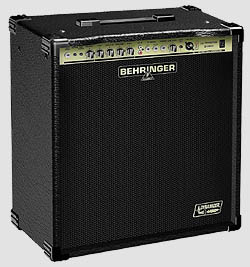
So now I have essentially a working speaker cabinet (4 ohms DC resistance, by the way) and a pile of unusable electronics. Anybody want parts and/or speaker cabinet (cheap, but you must pay actual shipping), send a note to
.
After reading some employee reviews and watching a YT video on Behringer, it seems that Music Tribe has a variety of issues to work through. On top of the nightmare that is a lack of parts availability due to ongoing COVID19 related supply disruptions. Music Tribe hired someone to track down the many bad employee reviews and post a disclaimer suggesting that people should visit their FB page for ‘the real story’ - as if anybody would believe that bullshit
That said, over a period of years I have evolved the impression that Behringer themselves are not real big on customer service, support and particularly in providing spares. Preferring instead to push out and flog new products.
I don’t really follow bass amps and wasn’t really aware that there was another incarnation of their 180W bass amp, the BX1800 with 15”. On the face of it, this sounds like it should be a better amp/speaker combination, thanks to the additional speaker surface area. Of course, that’s all moot when it becomes a pile of Behringer junk parts ... good luck!
190712 -
(Excellent) Was going to buy one of these amps used ... but not now. Thank you for the info.
190609 - (Excellent) Very good, thorough review. Thank you. I have a 180W Bass amp from Behringer, and I have to say I'm happy with it - apart from it's not loud enough
.Editor's Note: Thanks. Yep, the first paragraph kind of sums it up " ... more than adequate for rehearsals and will hold its own in smaller venues". The claim of it being 180W is a bit dubious.
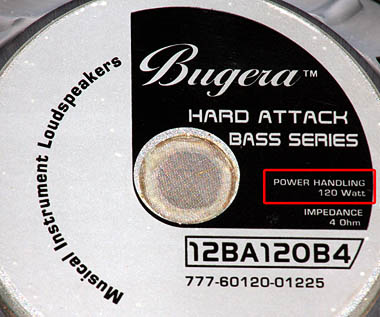 190524 -
Sadly, the first comment for this article was from an armchair expert that couldn't be bothered to check their facts. And I quote:
190524 -
Sadly, the first comment for this article was from an armchair expert that couldn't be bothered to check their facts. And I quote:
"Given Rating: Useful (ignored ;-)
Notes: Partially. When opening to look at the speaker it says 1000W Peak and 250W continuous. The whole story above has been discussing a speaker less than that so maybe they learned from their mistake or your amp had a mistake to begin with?"
I have very little patience for idiots these days ... so I'll cut to the chase.
Firstly - Lucky you!
Your speaker is rated at double Behringer's stated spec for this amp (which is more than just a little unusual these days
However - If a Behringer Ultrabass BXL1800A contains a speaker labeled other than the one in the photo over there to the right, (power handling within the red border stated as 120W), then it is NOT the original speaker.
The speaker in the picture, is the one in Behringer's specifications, that ships with this amp.
In the speaker box mentioned above by my esteemed (or maybe just 'steamed up') visitor, the original Bugera would have been replaced with a not-so similar 12" speaker - quite possibly (though I can't know for sure), a 12" sub woofer from a Eurolive F1220D PA speaker or the like (which is rated at 250W or thereabouts. You know, it's a Behringer thing).
There are NO 250W, 12" speakers for ANY of the bass amps in the Behringer Ultrabass BXL XXXX range.
It should be noted, that getting any replacement parts for the Behringer Ultrabass BXL1800A is becoming
So don't be surprised to find, shall we say, "interesting" components inside the box if you purchase a used Behringer Ultrabass BXL1800A. For example, the blown power amp that I replaced (mentioned above) had been repaired at least twice before, using non-standard (non-Behringer) parts. Generally that would be my "last resort" strategy, however given the scarcity of available replacement parts/modules, all options are now on the table (sadly, including landfill).
Incept Date: Wizard - 150520 - posted 180315
Last Update: Wizard - 230325

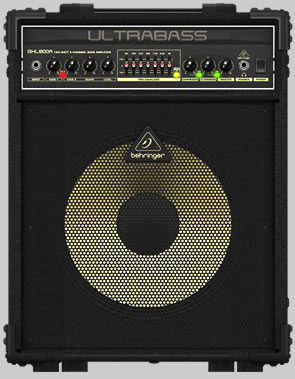 BXL1800A Front View
BXL1800A Front View 